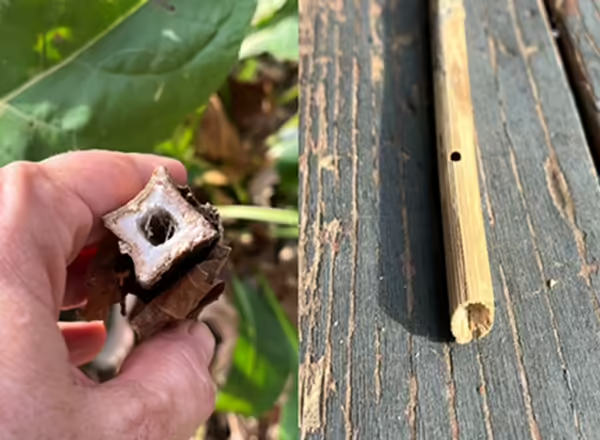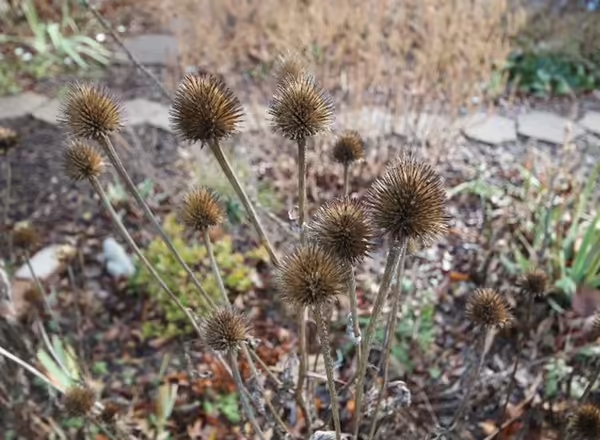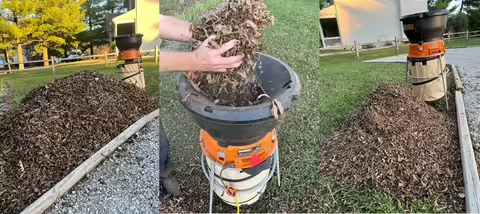
Providing winter hospitality to both vertebrate (birds mammals, lizards, etc.) and invertebrate (insects, spiders, worms, etc) wildlife is an important consideration when tidying the garden at the end of the season.
It really is a balancing act on how much fall cleanup to do. On the one hand, maintaining an attractive landscape year-round is an overall goal for most, but doing so while providing wintering habitat for beneficial insects and wildlife is even better. I try viewing my yard from the perspective of wildlife and make every effort to maximize my hospitality on two key points when adding plants or doing any maintenance.
- Does this plant provide a food source?
- Does this provide shelter from the elements and/or predators?
Don’t throw away your leaves
My goal is to keep all fallen leaves on site to recycle the nutrients and organic matter still contained in them...it’s like getting free slow-release fertilizer on top of enhancing the health of the garden by creating valuable compost for enriching the topsoil.
There is another reason though to retain leaves in the garden. A number of beneficial insects overwinter as larvae, pupae or adults in leaf litter and loose soil. I commonly encounter larvae like the giant leopard moth (Hypercompe scribonia) or the woolly bear/Isabella tiger moth (Pyrrharctia isabella) in the fall and spring amongst the fallen leaves. Once you realize how many things can be squashed by you mucking about in a leaf covered bed, you tend to take a much less intrusive approach.
Methods for mulching leaves
In my turf areas, I mulch some of the leaves with a mulching mower and allow the little pieces to fall down into the canopy to further break down over time. Mulching the leaves speeds the decomposition process and is less likely to smother the grass if not overdone. Leaving excessive leaves or leaf mulch on lawn going into winter is not ideal for a number of reasons, including disease development and inhibition of growth next spring.
It also provides great cover for turf damaging critters like mice and voles. If I have more leaves than I can safely mulch into the standing grass, they are blown into adjacent flower beds or raked up for use elsewhere. I try to mimic nature by keeping the depth to no more than six inches deep in flower beds around plants and under trees. With a leaf blower it is very easy to smother plants and in some cases redistribution of heavy spots with a broom or by hand is needed.
Another tool that’s handy to have is an electric leaf mulcher with a bag catcher. I tend to use this to mulch large volumes of leaves like those that have fallen on the sidewalks and driveways. Once I have all my excess leaves blown or raked into a big pile, I can quickly run the leaves through the mulcher and reduce it by at least half, if not more. With the bag catcher, I can then distribute the leaf mulch in areas of need.

Retain hollow or pithy stems
The Xerces Society has a really great reference for Nesting & Overwintering Habitat for Pollinators & Other Beneficial insects. It not only explains the importance of retaining spent stems for cavity-nesting insects, but also how to go about creating optimal nesting sites in terms of timing and placement of pruning cuts. I don’t know that I ever really focused on whether a plant had a hollow stem, a pithy stem, or a solid stem unless I needed that information for identification purposes, but now I get really excited when I find hollow or pithy stems which are optimal for cavity nesting sites.

There are many garden plants whose retained seed can be an important winter food source for birds and wildlife. In my yard, this is especially true for plants like coneflower (Echinacea sp.), black-eyed Susan (Rubdbeckia sp.), Joe-Pye weed (Eutrochium sp.), and stonecrop (Sedum sp.). But like having a birdfeeder, there is always some seed that drops to the ground and is missed by ground-feeding birds or other wildlife, increasing the chance extra plants will “pop up” next year.
Some plants I am not willing to take the risk of them spreading, and two that come to mind immediately are garlic chives (Allium tuberosum) and certain selections of Japanese anemones (Eriocapitella spp. and hybrids). Both of these plants can spread rapidly by seed and are difficult to remove even as young plants, so I deadhead them before they get a chance to spread their seed around.
MEET THE AUTHOR
Elizabeth Wahle is a Commercial Agriculture Educator with University of Illinois Extension, and her major focus and expertise is the Illinois commercial specialty crop industry. Elizabeth provides program leadership for a number of program events for commercial growers including From Food to Flowers, the Southern Illinois Fruit and Vegetable School and the Gateway Green Industry Conference. In addition to her statewide duties, Elizabeth also provides consumer horticultural support to University of Illinois Extension in Madison, Monroe, and St Clair counties. Marrying the two responsibilities, Elizabeth is dedicated to creating educational resources that build and sustain viable food webs and ecosystems.
